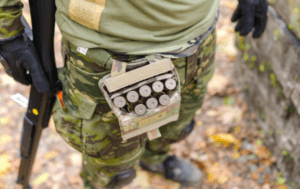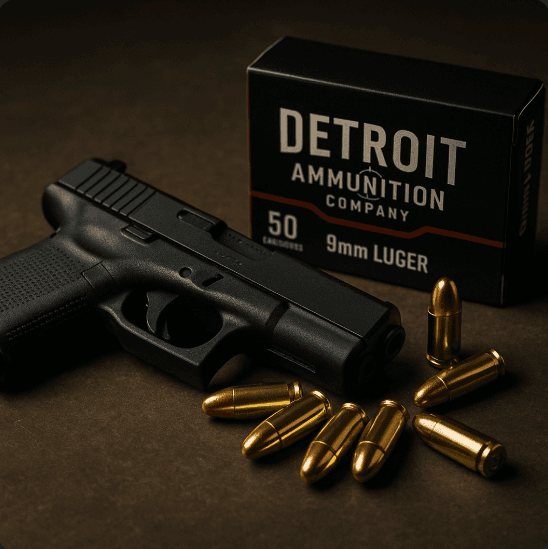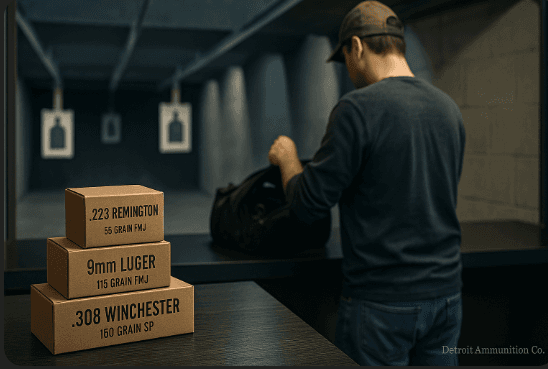How to Choose the Right Ammunition for Your Firearm?
Posted Mar 13, 2022

Choosing the correct ammunition for your gun is challenging. There are various considerations to take when shopping for ammunition. You must know what you plan on using the ammunition for, which ammo type is illegal, and which ammunition is less suitable for your weapon. Let’s discuss ways to choose the appropriate ammunition for hunting, target shooting, and self-defense.
Factors to Consider When Choosing Ammunition for Firearms
Stopping Power
Stopping power is the ammunition’s ability to deter or stop a threat. Stopping power is often mistaken for knockdown power, but the two have different connotations. The two most important criteria for ammunition terminal performance are penetration and expansion.
Some factors affecting the terminal performance of the ammunition include caliber, composition, constriction, weight, shape, and the bullet’s impact velocity. Full metal jacket ammunition is the right choice for targeted practice with handguns. These bullets are non-deforming and highly penetrative, but they don’t expand in the soft tissue.
Other Criteria for Ammunition Selection
The first thing to consider when choosing ammunition for self-defense is functional reliability. Whether it’s a handgun, shotgun, or carbine, the ammo should cycle with 100% reliability. If you purchase a semi-automatic handgun for home defense or concealed carry, make sure to fire at least 100 rounds to break it in. Some characteristics of self-defense ammo, especially for handguns, are as follows.
- Bullet Expansion: Jacketed hollow-point bullets are perfect for anti-personal or defensive shooting. These bullets have controlled expansion, which makes them safe for self-defense.
- Bonded Cores: The ammunition should have bonded cores, as they minimize the likelihood of jacket and core separating whenever a round is fired.
- Nickel-Plated Brass Casings: The remarkable thing about nickel-plated brass is that it is reflective and corrosion-resistant. Its properties make it easier to figure out whether or not the chamber is loaded.
- Low-Flash Propellants: Low-flash propellants achieve uniform combustion in defensive firearm loads, especially in short and service-length barrels. They protect your night vision, especially in low-light circumstances.
Projectile Wounding Elements
Terminal Ballistics studies ammunition’s action and impact on a specific target. Terminal ballistics impact rockets, tank shells, and missiles on armor, bunkers, and vehicles in a military context.
For self-defense, the study of terminal ballistics is broken down into a subfield, “wound ballistics.” When choosing ammunition for self-defense, the terminal ballistic performance of the ammo is essential to consider. Here are some elements of projectile wounding.
- Sonic Pressure Wave: The sonic pressure wave is the high-magnitude wave propagating from the impact point.
- Temporary Cavitations: Temporary cavitation refers to kinetic energy transfer to the surrounding tissues. The damage to the tissues depends upon the elasticity limit. The liver, spleen, and other fluid-filled organs are susceptible to such mechanisms. On the flip side, muscle, lung, and bowel tissues are more resistant. If the bullet expands, kinetic energy transfer will be much better. Consequently, the volume of temporary cavitation will increase. Temporary cavitation is more significant in high-velocity and high-energy projectiles.
- Permanent Cavitation: Permanent cavitation is the volume of soft tissue permanently destroyed by the shot. The diameter and the frontal surface area impact the permanent cavity diameter. The bullets’ caliber, shape, and composition are critical in permanent cavitation.
- Penetration: Penetration refers to the medium through which the bullet passes before it rests or exits. When tested on calibrated ordnance gelatin, a bullet should penetrate up to 12 inches, which is standard for testing purposes. 15 inches is the optimal penetration depth, and 18 inches is the maximum. Penetration is necessary for inflicting an incapacitating wound. However, it might result in collateral damage if it’s too deep. There have been instances where people have been injured severely, while some have died.
Barrel Length
Barrel length plays a large part in selecting ammunition for handguns. Jacketed hollow points come with an expansion threshold, the minimum velocity needed for reliable expansion. In shorter barrels, like the ones on a Smith and Wesson revolver, the muzzle velocity is insufficient to meet the expansion threshold of +P expanding and standard pressure bullets.
It leads to unreliable expansion in the soft tissues, thus minimizing the terminal performance of the ammo. To troubleshoot this problem, use sharp-shoulder and flat nose bullets. Unlike round nose bullets, flat-nose bullets are more likely to crush a tissue.
Choosing the Best Shotgun Ammo
There are three different types of shotgun ammo, but first, let’s discuss what to look for in shotgun ammunition.
- Gauge: Gauge is a metric that measures the shotgun size and the barrel diameter. Contrary to popular belief, the gauge is not the measure of the length but the weight of the shell. The term “gauge” comes from the way cannons were measured according to the weight of the cannonball. 12-Gauge shotguns use around that is 1/12th of a pound.
- Shot: Shots are the pellets in the shell that spread when a shotgun is fired. These pellets are numbered according to their size. Birdshot is the smallest, while buckshot is the largest. The pellets are measured according to their diameter.
Birdshot: An Overview
As the name suggests, birdshot is used for hunting smaller animals like birds, rabbits, and squirrels. It is also used in sports like skeet-shooting, and some people use it on pests like snakes and lizards. The number of pellets in birdshot depends upon the size of the pellet and the size of the shell. For example, 2.75-inch 12 gauge shell contains 97 pellets for a #2 shot. However, for a #9 shot, there are 715 pellets.
Like shotshells, the number associated with birdshot sizes is opposite of the normal numbers. For example, #2 shots are larger than #9 shots. Some common sizes for birdshot are #7, #7.5, #8 and #9. These sizes are mentioned on the packaging of the shotshells. The average range of the birdshot is 40 yards.
Buckshot: Birdshot’s Bigger Sibling
It is a no-brainer; buckshot is used for hunting larger animals like bucks and deer. The build of the cartridge is similar to that of birdshot. However, the shots inside the cartridge are larger. Besides hunting, buckshot is used for target shooting and self-defense. Like the birdshot, the shotshell sizes of the buckshot are opposite to the standard numbers.
For example, the #4 shot is smaller than a #1 shot. The former contains approximately 20-25 pellets per ounce, and the latter contains 10-12 pellets per ounce. The most common size for buckshot is the 00 Buck, also known as the Double Ought Buck. This buckshot is larger than the #1 buck but smaller than the 000.
The number of pellets in a cartridge depends upon the size of the pellets and the shell they are loaded in. Because the shots are larger than birdshot, buckshot cartridges have a smaller number of pellets in them. For example, a 12 gauge buckshot has 8 pellets, while a 3-inch shell has 12 pellets. The range of buckshot is somewhere between 30-40 yards.
An Overview of Slugs
Shotguns are designed to shoot multiple projectiles simultaneously. Slugs, on the other hand, function like regular bullets. They are fired from specialized slug barrels that contain rifling grooves. The grooves stabilize a slug’s flight. It means a slug can deliver higher energy than birdshot or buckshot. Slugs can also cover a longer distance.
Steel and lead are two of the most common materials used in making slugs, but other materials are too. For example, rubber slugs are used for less lethal applications. On the flipside, slugs for hunting and gun spots are made of brass and contained in a plastic sabot for a more stable flight.
A slug can travel up to 75 yards because its projectile is similar to the projectile of a bullet. Interestingly, slugs can touch the 100 yards mark with the right firearm. Slugs are used in competition sports, hunting, and more extreme situations that call for breaching doors and vehicles.
Choosing Ammo for Handguns and Rifles
When choosing ammunition for rifles and handguns, check the barrel stamp on the firearm and carefully compare it with the description on the ammunition packaging. Bullets for rifles and handguns are made of lead and covered in brass or copper. Bullets for hunting tend to expand, while gun sports leave smaller holes on the target.
Common Rifle Bullets
- Full Metal Jacket: These bullets ensure maximum penetration without any mushrooming. However, they are illegal for the big hunting game in most states.
- Rounded Soft Point: Rounded-Soft points are known for low-velocity calibers and work perfectly in tubular magazines.
- Pointed Soft Points: These high-velocity bullets travel in a straight trajectory. They are accurate bullets and provide excellent mushrooming.
- Protected Tips: These bullets are accurate and provide excellent expansion.
Common Handgun Bullets
- Wad Cutters: These bullets are flat-ended and perfect for target shooting. They cut open a clean hole in the paper and similar surfaces.
- Semi-Wad Cutters: They balance penetration and expansion.
- Full Metal Jacket: They provide full penetration but no expansion.
- Round Nose Lead: Unlike full metal jacket bullets, these bullets provide good penetration and slight expansion.
- Hollow Point: They provide high expansion upon impact.
When choosing ammunition for rifles, the caliber of your rifle is the most crucial factor to consider. The caliber is the measure of a bullet’s diameter. The bigger the diameter, the bigger the bullet. However, the caliber is just one characteristic that makes up rifle ammunition. Length is another important consideration.
It is in your best interest to use the same ammunition stamped onto the receiver or the barrel of your rifle. Using any other ammunition can damage the firearm while causing a potentially fatal injury. For example, if the receiver or the barrel says “.300 Win. Mag.” don’t make the mistake of using “300 WBY. Mag.” or “.300 Win. Short Mag.” or .300 Rem. Ultra Mag.”.
Some Popular Ammunition Brands
Federal HST
In 2002, the Federal introduced the HST line of the JHP bullets. Initially, these bullets were used only by law enforcement professionals. HST is a brand known for striking the perfect balance between expansion and penetration. In 2015, Federal s started manufacturing ammunition for civilians as well.
Speer Gold Dot
Speer Gold Dot is one of the best brands for defensive handgun ammunition. Their bullets are made from the electrochemical bonding process, which eliminates any chance of the core separating from the jacket, thus maintaining the bullet’s integrity.
Hydra Shok
Hydra Shok is a famous ammunition brand released by Federal in 1988. They were made to meet the FBI’s requirements on terminal wounding.
This brand, “Hydra Shok,” is named after hydrostatic shock. These bullets contain a hollow point jacket and a center post. Sadly, the core is non-bonded, which may compromise the bullet’s integrity.
Hornady Critical Defense
Critical Defense is one Hornady’s of best ammunition brands for rifles and handguns. These bullets contain a flex-tip insert that provides good expansion, regardless of the penetrated fabric. However, heavy fabrics like denim can plug the nose cavity of a JHP bullet, which makes it perform just like a full metal jacket.
The Final Word
Whether it is a shotgun, a handgun, or a rifle, choosing the correct ammunition is essential. The wrong ammunition can cause severe damage to your gun, and it can be dangerous to the shooter.
Make sure you check out all the considerations and the different brands we have mentioned above before buying a pack of bullets. Detroit Ammo Co. is the place for you for the best ammunition and gear, gun parts, and reloading supplies.
We help gun owners make a well-informed decision about their ammunition and gun parts. We also publish well-researched blogs that keep gun owners updated on the latest gun maintenance techniques, as well as the laws surrounding gun control.
To get in touch, feel free to visit our website today.


